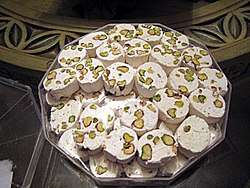Gaz (candy)
 Persian Nougat | |
| Type | nougat |
|---|---|
| Place of origin |
|
| Region or state | Isfahan |
| Main ingredients | Gaz of Khunsar/esfahan or sugar or corn syrup, pistachio or almond kernels, rosewater, egg whites |
Gaz (Persian: اصفهان گز) is an Iranian nougat. It is widely known as Persian Nougat in American and European countries.
Etymology
The Persian word Gaz is associated with gaz-angebin which translates to 'sap of angebin', in reference to a species of Tamarisk, T. gallica[1] that is native to the Zagros mountain range located to the west of the Esfahan.Gaz is one of the most popular souvenirs of Isfahan. The raw material for this famous sweet is manna which is obtained around the city. The history of making Gaz in Isfahan backs to 450 years ago which was made in the different types of flour, bread, including pistachios, almonds and chocolate in traditional and industrial workshops. Gaz manna is the root of a plant which is called bush or Gaz tree. The height of this mountain tree reaches a height of two meters and it usually grows in good weather in the mountains of Bakhtiari and Khansar. The product of this tree becomes ready to harvest in the late summer and the shiny and yellow grains come out in the stems like millet. At this time, the owners of the trees must harvest them before the autumnal rains.http://en.rasekhoon.net/article/show/1087384/isfahan-gaz/
Manufacture and style
The sweet, milky sap (gaz of Khunsar) found on the angebin plant is associated with manna, a food mentioned in the religious texts of the Abrahamic religions. The sticky white substance is formed from honeydew, which is exuded from the anus of the nymph of a psyllid insect, either Cyamophila astragalicola[2] or C. dicora,[3] in its final instar, which live on plants of Astragalus adscendens,[2] and is collected annually and is combined with other ingredients including pistachio or almond kernels, rosewater and egg white. Modern versions of gaz may not contain gaz of Khunsar and may use sugar and corn syrup as substitutes for psyllid manna.[4][5]
The traditional way to serve gaz is in round pieces that are about 2 inches in diameter and up to 1/2-inch thick. A modern presentation is to serve the nougat cut into smaller rectangles.[6] Depending on the ingredients mixed in, gaz can have a subtle rose flavor, a nutty taste, or a savory and pungent profile. It can be white, or it can become another color because of the addition of spices (such as saffron) or nuts.[6]
Nowruz
Celebrations such as Nowruz, the Persian New Year, feature gaz.[6] During the Nowruz holiday, family and friends visit each other's homes and, typically, the host offers fruits and sweets to their guests. Served with sherbet or tea, gaz is a favorite delicacy and a much-appreciated gift as it helps to ensure that a household will have ample snacks to serve all holiday visitors.[6]
See also
References
- ↑ Wulff, Hans, M.I.T. Press, 1966, The traditional crafts of Persia: their development, technology, and influence on Eastern and Western civilizations
- 1 2 Grami, Bahram (1998). "Gaz of Khunsar: The manna of persia". Economic Botany. 52 (2): 183–191. doi:10.1007/BF02861207. Retrieved 2012-01-04.
- ↑ "Gaz(1)". Encyclopædia Iranica. 2000. Retrieved 2012-01-04.
- ↑ http://candy.about.com/od/nougatcandyrecipes/r/persian_nougat.htm
- ↑ "Archived copy". Archived from the original on 2013-05-10. Retrieved 2012-01-05.
- 1 2 3 4 "Heavenly Persian Nougat – Candy Atlas". Candy Atlas. Retrieved 2015-10-29.